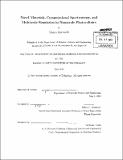| dc.contributor.advisor | Jeffrey C. Grossman. | en_US |
| dc.contributor.author | Bernardi, Marco, Ph. D. Massachusetts Institute of Technology | en_US |
| dc.contributor.other | Massachusetts Institute of Technology. Department of Materials Science and Engineering. | en_US |
| dc.date.accessioned | 2013-11-18T19:09:52Z | |
| dc.date.available | 2013-11-18T19:09:52Z | |
| dc.date.copyright | 2013 | en_US |
| dc.date.issued | 2013 | en_US |
| dc.identifier.uri | http://hdl.handle.net/1721.1/82331 | |
| dc.description | Thesis (Ph. D.)--Massachusetts Institute of Technology, Dept. of Materials Science and Engineering, 2013. | en_US |
| dc.description | Cataloged from PDF version of thesis. | en_US |
| dc.description | Includes bibliographical references (p. 96-104). | en_US |
| dc.description.abstract | Photovoltaic (PV) solar cells convert solar energy to electricity using combinations of semiconducting sunlight absorbers and metallic materials as electrical contacts. Novel nanoscale materials introduce new paradigms for ultrathin, lightweight, solution processable PV as an alternative to conventional Si technology. For example, the ability to use deposition methods not viable in conventional inorganic PV is particularly exciting as products like paper, textiles, automobiles, and building materials could be coated with PV devices, thus making solar cells ubiquitous. In addition, the optical absorption, band gap, and charge carrier mobility of nanoscale materials can be tuned by tailoring their chemistry or using quantum confinement effects, thus creating novel opportunities for efficient and inexpensive solar cells. From the viewpoint of the fundamental processes involved in PV operation, nanoscale PV poses additional challenges due to the formation of strongly bound electron-hole pairs (excitons) upon photoabsorption requiring the presence of semiconductor heterointerfaces within the active layer to dissociate excitons and generate charge carriers. Such interfaces are known as donor-acceptor (D-A) interfaces, and their presence leads to correlated exciton and charge dynamics in nanoscale PV. Material combinations suitable for nanoscale PV can be predicted using atomistic quantum mechanical calculations, which further enable the computation of a small number of spectroscopic quantities necessary to estimate the power conversion efficiency. Our work shows the computational design of two novel classes of materials for nanoscale PV displaying optical absorption, stability, tunability, and carrier mobility superior to materials employed so far in nanoscale PV. To this end, we employed simulation techniques generally falling under the umbrella of ab initio atomistic electronic structure methods, including density functional theory (DFT) and the GW-Bethe-Salpeter approach. Proof-of-concept PV devices were fabricated and tested within our group and in collaboration with other experimental research groups. The two material families studied in this thesis include carbon based materials (both in nanoscale and bulk form) and two-dimensional monolayers such as graphene, reduced graphene oxide, boron nitride, and transition metal dichalcogenides. Our work demonstrates the feasibility of novel PV devices with a range of benefits employing such materials. It further develops a framework to accurately predict exciton dissociation at D-A interfaces and estimate efficiencies in nanoscale PV. Beyond our work on nanoscale materials, we introduce a combination of methods to enable simulation of nanoscale PV across time and length scales. We discuss modeling of subpicosecond dynamics at D-A interfaces, device-scale transport of excitons, charge carriers, and photons, and macroscopic sunlight management by arranging solar panels to best couple with the Sun's trajectory. We elaborate on the latter point and discuss our work on simulation and fabrication of macroscopic three-dimensional PV structures with promise to deliver a range of benefits for solar energy conversion, including reduced seasonal and latitude sensitivity and a doubling of peak power generation hours. Taken together, this thesis advances the computational design of nanoscale PV systems and introduces novel families of materials and PV structures with technological promise for next-generation PV. This thesis document is organized as follows: Chapter 1 and Chapter 2 introduce, respectively, nanoscale PV and ab initio atomistic simulation methods employed in this work. Chapter 3 is the core of our work on novel families of materials for nanoscale PV, and Chapter 4 illustrates multi-scale simulation methods in nanoscale PV as well as our work on three-dimensional PV. The key results are briefly summarized in Chapter 5. | en_US |
| dc.description.statementofresponsibility | by Marco Bernardi. | en_US |
| dc.format.extent | vii, 104 p. | en_US |
| dc.language.iso | eng | en_US |
| dc.publisher | Massachusetts Institute of Technology | en_US |
| dc.rights | M.I.T. theses are protected by
copyright. They may be viewed from this source for any purpose, but
reproduction or distribution in any format is prohibited without written
permission. See provided URL for inquiries about permission. | en_US |
| dc.rights.uri | http://dspace.mit.edu/handle/1721.1/7582 | en_US |
| dc.subject | Materials Science and Engineering. | en_US |
| dc.title | Novel materials, computational spectroscopy, and multiscale simulation in nanoscale photovoltaics | en_US |
| dc.type | Thesis | en_US |
| dc.description.degree | Ph.D. | en_US |
| dc.contributor.department | Massachusetts Institute of Technology. Department of Materials Science and Engineering | |
| dc.identifier.oclc | 861621158 | en_US |
